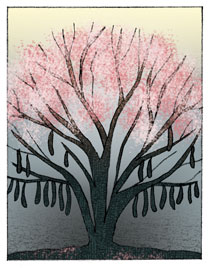Issue Archive
Commentary: Betrayal: A Name Change

Every spring I admire the purple-pink flowers on the redbud tree. Its other name, the Judas tree, puzzled me until the autumn day when seedpods hung from the branches. Then I saw corpses.
The discovery of The Gospel of Judas, a Gnostic text, has changed all that for me. Written two millennia ago, and published in April 2006, how would it have altered the world if carbon testing had dated it a few decades earlier, contemporary with New Testament gospels? What does it mean to the Judeo-Christian world that it has reached us at all?
We thought we knew the story of Judas Iscariot. One of the 12 disciples, Judas was at the Passover Seder (“Last Supper” in Christian iconography). He betrayed Jesus to the Jewish authorities; they turned him over to the Romans who crucified him. Judas was paid 30 pieces of silver, then he hanged himself. He did it, says the legend, from the redbud tree.
Canonized in new testament gospels, the story is preached in Christian churches and engraved in Christian hearts. The very name of Judas, the man reviled for this betrayal, came to represent all Jews, and all Jews became killers of Christ. Out of this scapegoating every possible atrocity was visited on the Jews—annihilating pogroms, inquisitional trials and auto-da-fé’s, expulsions of entire populations whose worldly goods were seized. Jewish “Christ-killers” suffered unpunished cruelties that inexorably led to the Holocaust.
After publication of the Judas gospel, Marvin Meyer, a Christian scholar, commented: “Judas as this evil Jewish person who turned Jesus in set the flames of anti-Semitism.” (Will things be different now?)
Another commentator said the Judas gospel portrays an “indispensable act of betrayal.” Why? Judas’s intervention permitted Jesus’ sacrifice upon which Christian theology was built—a self-sacrifice that in effect was closer to assisted suicide. Why, I have often wondered, if Christians thought that sacrifice was part of God’s design, would they blame anyone who helped fulfill what they believed was Jesus’ destined role?
A model exists in the Bible story of Joseph and his brothers. Joseph’s dream that he will rule over his brothers is too much for his jealous siblings. Already enraged that their father, Jacob, prefers Joseph to them, they sell their brother into slavery. By the time famine in Canaan forces the brothers to travel to Egypt, Joseph has risen to power there. When the brothers realize that the man they are pleading with is the one they betrayed, they tremble with fear. But Joseph, in the great recognition scene of Genesis 45:5-8, tells them: “Do not be angry with yourselves for selling me to this place…. It was not you who sent me here, but God….”
Annually read in synagogues at Hanukka time—this year it was in proximity to Christmas—the Joseph story lends a logical way for Christians and Jews (those who still care) to look at Judas’s enabling of the earthly death Jesus so passionately sought.
The Gospel of Judas came too late for Christian canon; can it be seen as a sort of midrash? Midrash has a way, when powerful enough, of entering the popular mind. Rabbinic midrash, for example, pronounced Ketura, the wife Abraham took after Sarah died, the concubine Hagar, thus righting the wrong of her banishment. Another Gnostic gospel, Mary, transforms the New Testament Magdalene from prostitute to Jesus-disciple and possibly his lover. Who, having read these belated texts, can forget them? Though Pope Benedict declared the Judas gospel heresy, how can it exert its counter-power? As for me, I no longer see corpses on the redbud tree. Each one is again a seedpod, from which a beautiful redbud may rise.










 Facebook
Facebook Instagram
Instagram Twitter
Twitter
Leave a Reply